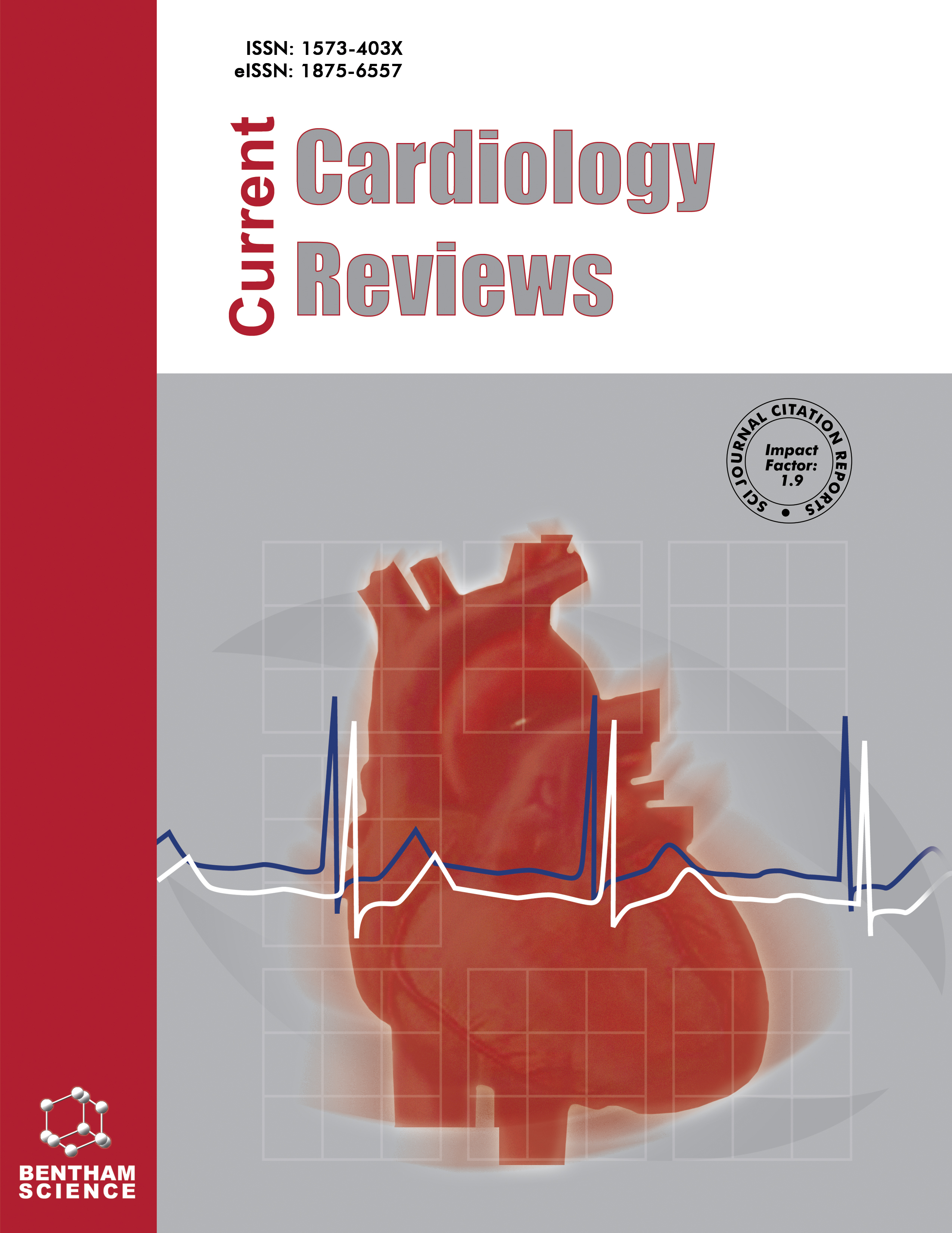- Home
- A-Z Publications
- Current Cardiology Reviews
- Previous Issues
- Volume 15, Issue 4, 2019
Current Cardiology Reviews - Volume 15, Issue 4, 2019
Volume 15, Issue 4, 2019
-
-
Physiological and Pathological Role of TRPV1, TRPV2 and TRPV4 Channels in Heart
More LessTransient receptor potential vanilloid channel 2 (TRPV2) is required for normal cardiac contractility. The stimulation of TRPV1 in isolated cardiomyocytes can aggravate the effect of hypoxia/ reoxygenation (H/R) on H9C2 cells. The knockout of the TRPV1 gene promotes increased tolerance of the isolated perfused heart to the impact of ischemia/reperfusion (I/R). However, activation of TRPV1 increases the resistan Read More
-
-
-
Hyponatremia in Heart Failure: Pathogenesis and Management
More LessHyponatremia is a very common electrolyte abnormality, associated with poor short- and long-term outcomes in patients with heart failure (HF). Two opposite processes can result in hyponatremia in this setting: Volume overload with dilutional hypervolemic hyponatremia from congestion, and hypovolemic hyponatremia from excessive use of natriuretics. These two conditions require different therapeutic approaches. While Read More
-
-
-
Percutaneous Pulmonary Valve Implantation: Current Status and Future Perspectives
More LessPatients with congenital heart disease (CHD) with right ventricle outflow tract (RVOT) dysfunction need sequential pulmonary valve replacements throughout their life in the majority of cases. Since their introduction in 2000, the number of percutaneous pulmonary valve implantations (PPVI) has grown and reached over 10,000 procedures worldwide. Overall, PPVI has been proven safe and effective, but some anatomical vari Read More
-
-
-
Hematological Parameters as Prognostic Biomarkers in Patients with Cardiovascular Diseases
More LessCardiovascular diseases are the major causes of preventable health loss from disease in the world and lead to functional disturbances including hematological parameters. The inflammatory and hypoxemic nature of cardiovascular diseases causes a stimulus in the bone marrow and, depending on the intensity of this stimulus, there is a release of immature cells or increase of other cells in the bloodstream. Therefore, Read More
-
-
-
Atrial and Brain Natriuretic Peptides- Benefits and Limits of their use in Cardiovascular Diseases
More LessAuthors: Mustafa E. Roxana, Târtea Georgică, Donoiu Ionuţ, Moise Gianina and Florescu CristinaNatriuretic peptides, produced by cardiac myocytes, are regulators of the intravascular volume and blood pressure, and also exhibit neuroendocrine, metabolic and growth controlling effects. In heart failure, their synthesis increases exponentially as part of the neuroendocrine activation, but their beneficial effects are diminished. The paper reviews relevant data about their role as diagnosis and prognosis mark Read More
-
-
-
Heart Failure and Cognitive Impairment: Clinical Relevance and Therapeutic Considerations
More LessHeart failure (HF) is a devastating condition characterized by poor quality of life, numerous complications, high rate of readmission and increased mortality. HF is the most common cause of hospitalization in the United States especially among people over the age of 64 years. The number of people grappling with the ill effects of HF is on the rise as the number of people living to an old age is also on the increase. Several facto Read More
-
-
-
Low-Dose Radiation Advances in Coronary Computed Tomography Angiography in the Diagnosis of Coronary Artery Disease
More LessAuthors: Caryl E. Richards and Daniel R. ObaidBackground: Coronary computed tomography angiography (CCTA) is now widely used in the diagnosis of coronary artery disease since it is a rapid, minimally invasive test with a diagnostic accuracy comparable to coronary angiography. However, to meet demands for increasing spatial and temporal resolution, higher x-ray radiation doses are required to circumvent the resulting increase in image noise. Exposure to high dos Read More
-
-
-
Extensively Thrombosed Ectatic Circumflex Coronary Artery Fistula Presenting as Acute Coronary Syndrome
More LessAuthors: Nooraldaem Yousif, Mohammady Shahin, Robert Manka and Slayman ObeidBackground: Coronary artery fistula (CAF) is an abnormal communication between the termination of a coronary artery or its branches and a cardiac chamber, a great vessel or other vascular structure. Symptomatic patients with large CAF should undergo surgical or percutanous closure of the fistula at the drainage site while still the debate on closing asymptomatic CAF and reopening symptomatic occluded CAF is ongoin Read More
-
Volumes & issues
-
Volume 21 (2025)
-
Volume 20 (2024)
-
Volume 19 (2023)
-
Volume 18 (2022)
-
Volume 17 (2021)
-
Volume 16 (2020)
-
Volume 15 (2019)
-
Volume 14 (2018)
-
Volume 13 (2017)
-
Volume 12 (2016)
-
Volume 11 (2015)
-
Volume 10 (2014)
-
Volume 9 (2013)
-
Volume 8 (2012)
-
Volume 7 (2011)
-
Volume 6 (2010)
-
Volume 5 (2009)
-
Volume 4 (2008)
-
Volume 3 (2007)
-
Volume 2 (2006)
-
Volume 1 (2005)
Most Read This Month
Article
content/journals/ccr
Journal
10
5
false
en


